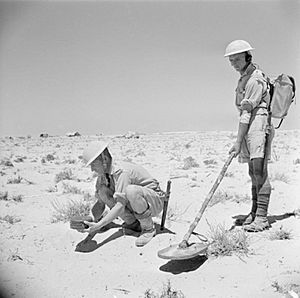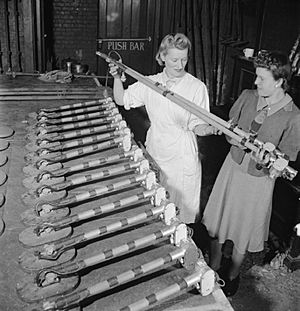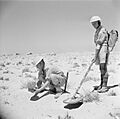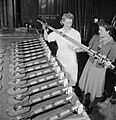Polish mine detector facts for kids
The Mine detector (Polish) Mark I was a special device used to find hidden landmines. It was like a metal detector but made specifically for finding dangerous explosives buried in the ground. This important tool was created during World War II. The first ideas for it came from Poland. However, because of the invasion of Poland in 1939 and then the Fall of France in 1940, the work was finished later. Polish lieutenant Józef Kosacki completed the design in the winter of 1941–1942.
Contents
How the Mine Detector Was Invented
Before World War II began, Poland's Ministry of National Defence wanted a device. They needed something to help find unexploded bombs, called duds, on their artillery training fields. A company called AVA Wytwórnia Radiotechniczna designed this instrument. But the German invasion of Poland stopped them from making it.
After Poland was invaded, Polish military leaders moved to France. They started working on the device again, but this time it was meant to be a mine detector. We don't know much about this part of its story. The work stopped again when the Battle of France happened. The Polish team had to move quickly to Great Britain for safety.
Who Invented the Mine Detector?
In Great Britain, in late 1941, Lieutenant Józef Kosacki created the final version of the mine detector. He used some of the earlier designs to help him. What's amazing is that he didn't try to get a patent for his invention. Instead, he gave it as a gift to the British Army! The King even sent him a special letter to thank him for his generosity.
How the Mine Detector Helped in World War II
The British Army quickly accepted Kosacki's design. They immediately sent 500 of these new mine detectors to a very important battle. This was the Second Battle of El Alamein in North Africa. The detectors helped the British Eighth Army move twice as fast! They could clear paths through minefields much more quickly and safely.
During the war, over 100,000 of the Mark I type were made. Even more advanced versions, like the Mark II, Mark III, and Mark IV, were also produced. These detectors were used in many other big battles. They helped soldiers during the Allied invasion of Sicily, the Allied invasion of Italy, and the Invasion of Normandy. The British Army kept using this type of detector for a very long time, all the way until 1995!
Trying to Make Vehicle-Mounted Detectors
People also tried to put mine detectors on vehicles. This was to keep the soldiers, called sappers, safer. Two special vehicles were developed for this: "Lulu" (built on a Sherman tank) and "Bantu" (built on a Staghound armoured car). These vehicles had the detector parts on non-metal rollers. The rollers were on arms that stuck out from the vehicle. If a roller went over a mine or a piece of metal, a signal would show up inside the vehicle. Prototypes were built, but they were never used in real combat.
How the Mine Detector Worked
The Polish mine detector was clever in its design. It had two special parts called coils.
- One coil was connected to an oscillator. This part made a sound that you could hear.
- The other coil was connected to an amplifier and a pair of headphones.
When the coils got close to a metal object, like a landmine, the balance between them changed. This change sent a signal to the headphones, and the person using it would hear a sound. This told them there was metal nearby.
The whole device weighed about 30 pounds (which is about 14 kilograms). One person could easily carry and operate it. This simple yet effective design made it a vital tool for soldiers. The Mark 4c version of this detector was still used by the British Army until 1995, showing how good it was!
See also
- Demining
- Land mine
Images for kids





